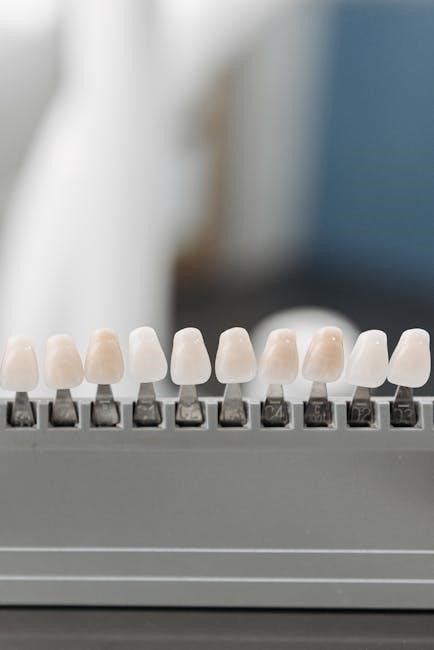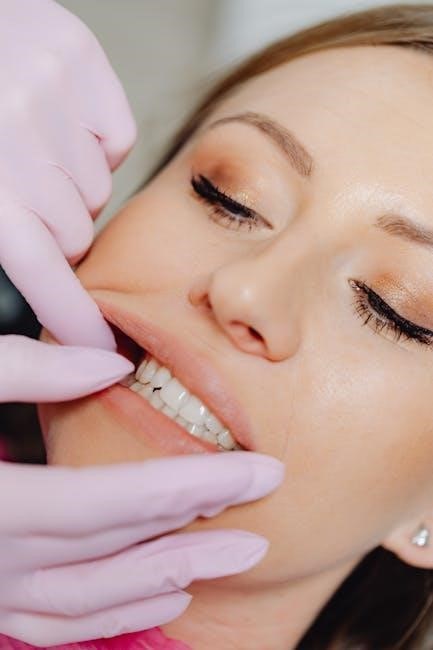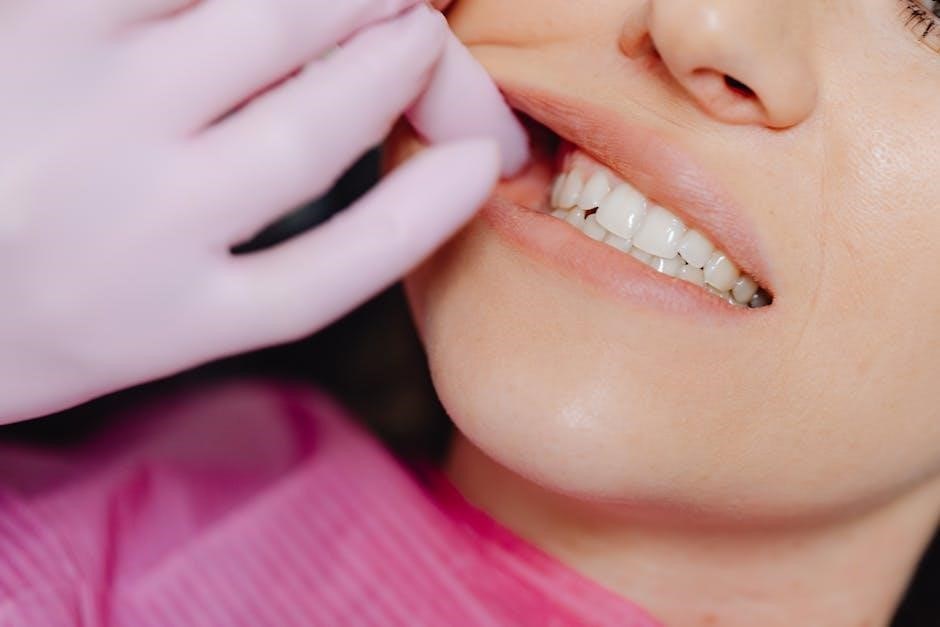Infancy (0-12 Months): Teething and First Teeth
Infancy marks the beginning of teething, with first teeth emerging around 6 months. Proper care and a first dental visit by 12 months are crucial for healthy development.
1.1 Signs of Teething in Infants

Common signs of teething in infants include drooling, gum swelling, irritability, and a strong desire to chew on objects. These symptoms typically appear around 6 months of age. Parents may notice red, sore gums and occasional fever. Teething can also cause sleep disturbances and loss of appetite. Some babies may experience mild swelling in the face or cheeks. It’s important to monitor these signs to ensure they remain within normal ranges. Offering cold teething toys or gently rubbing the gums can provide relief. If symptoms persist or worsen, consulting a pediatric dentist is recommended. Early recognition of teething signs helps in soothing the baby effectively.
1.2 Care Before Teeth Emerge
Before teeth emerge, proper oral care is essential to promote healthy development. Gently wipe the gums with a soft, clean cloth or a damp washcloth to remove bacteria and food residue. For infants under 18 months, wetting the toothbrush with water is sufficient; toothpaste is not recommended unless advised by a dental professional. This helps maintain a clean environment for the incoming teeth. Regular inspection of the gums can help identify early signs of teething or potential issues. Parents should avoid using sugary substances or pacifiers dipped in honey or sugar, as these can lead to early tooth decay. Consistent pre-teething care lays the foundation for a lifetime of healthy oral habits.

1.3 First Dental Visit Recommendations
The first dental visit is recommended by the time the child reaches 12 months of age or within six months of the first tooth erupting, whichever comes first. This initial visit is crucial for assessing oral health and identifying potential issues early. The dentist will examine the gums, any erupted teeth, and overall mouth development. Parents should be prepared to discuss their child’s oral care routine, diet, and any concerns. The dentist may also provide guidance on teething, fluoride use, and proper cleaning techniques. Early visits help establish a positive relationship with dental care and ensure a strong foundation for lifelong oral health. Regular check-ups from this point onward are essential for monitoring development and preventing cavities.

Toddlerhood (1-3 Years): Primary Teeth Eruption
During toddlerhood, primary teeth continue to erupt, typically completing the set of 20 teeth by age 3. Proper oral hygiene and regular dental check-ups ensure healthy development.
2.1 Timeline of Primary Teeth Eruption
Primary teeth eruption begins around 6 months and continues until the child is about 3 years old. The first teeth to appear are typically the lower front teeth, followed by the upper front teeth; By 12-18 months, molars start to emerge, and canines come in around 16-22 months. The process completes with the second molars, which appear between 22-28 months. This timeline may vary slightly, but most children have a full set of 20 primary teeth by age 3. Regular dental check-ups during this period help monitor proper eruption and overall oral health.
2.2 Caring for Primary Teeth
Caring for primary teeth is essential to ensure proper oral health and development. Start brushing your toddler’s teeth twice a day with a fluoride toothpaste, using a pea-sized amount. Gently clean all surfaces, focusing on areas where teeth and gums meet. Avoid sugary snacks and drinks to prevent decay. Encourage water after meals to rinse food particles. Regular dental visits help monitor growth and detect early signs of cavities. Teach your child to spit while rinsing to avoid swallowing fluoride. A soft-bristled toothbrush is ideal for gentle cleaning. Consistent care fosters healthy habits and a strong foundation for permanent teeth. Early intervention can address any issues promptly.
2.3 Dental Visit Frequency for Toddlers
Toddlers should visit the dentist every six months to monitor primary teeth development and prevent issues. The first visit should occur by 12 months or within six months of the first tooth erupting. Regular check-ups help identify early signs of decay or misalignment. Dentists may apply fluoride treatments to strengthen enamel. Parents should discuss oral hygiene routines, such as brushing techniques and diet, during these visits. For children under 18 months, the dentist may focus on visual exams and gentle cleanings. Consistent dental care fosters trust and sets the foundation for lifelong oral health. Early interventions can address concerns before they become serious, ensuring healthy primary teeth and proper development.

Early Childhood (4-6 Years): Mixed Teeth Phase
During early childhood, mixed teeth emerge as primary teeth fall out and permanent ones erupt. Regular brushing and dental check-ups ensure healthy development and prevent issues.
3.1 Eruption of Mixed Teeth
During early childhood, mixed teeth begin to emerge as primary teeth fall out and permanent teeth start to erupt. This phase typically starts around age 4 and continues until about 6 years old. The first permanent teeth to appear are usually the lower central incisors, followed by the upper central incisors. Molars also start coming in, often behind the primary teeth. This mixed dentition phase is crucial as it sets the foundation for the future alignment and health of the permanent teeth. Regular monitoring and dental check-ups are essential to ensure proper eruption and alignment, preventing potential orthodontic issues later on.
3.2 Oral Care for Mixed Teeth
Proper oral care is vital during the mixed teeth phase to ensure healthy development. Brushing twice daily with a fluoride toothpaste is essential, focusing on all surfaces of both primary and permanent teeth. Parents should assist children to ensure thorough cleaning. Interdental cleaning with floss or interdental brushes helps remove plaque between teeth, reducing the risk of cavities. Limiting sugary snacks and encouraging water intake after meals can prevent decay. Regular dental visits are crucial to monitor eruption and alignment. Teaching children good hygiene habits now sets the foundation for lifelong oral health. Consistency and supervision are key to maintaining healthy mixed teeth during this transitional phase.
3.3 Dental Visit Around 5-6 Years

A dental visit around 5-6 years is crucial for monitoring the transition from primary to permanent teeth. The dentist will assess the eruption progress, check for cavities, and ensure proper alignment. Fluoride treatments may be applied to strengthen enamel. This visit also provides an opportunity to apply sealants to newly erupted permanent teeth, protecting them from decay. Additionally, an orthodontic evaluation may be performed to identify any potential issues with bite or alignment. Parents receive guidance on maintaining oral hygiene and diet habits. Early detection of problems ensures timely interventions, promoting a healthy smile and preventing future complications. Regular check-ups at this stage are essential for long-term oral health and confidence.
Middle Childhood (7-10 Years): Permanent Teeth Begin
Middle childhood marks the beginning of permanent teeth eruption, typically starting with molars and incisors. Regular dental visits ensure proper development and prevent early issues, promoting lifelong oral health.
4.1 First Permanent Teeth Eruption
The eruption of the first permanent teeth typically begins around age 7, starting with the first molars and lower central incisors. These teeth are crucial as they set the foundation for the rest of the permanent dentition. Parents should monitor their child’s dental development to ensure proper alignment and spacing. Regular dental check-ups during this phase help identify any potential issues early, such as overcrowding or impacted teeth. Maintaining good oral hygiene practices, like brushing twice daily and avoiding sugary snacks, supports healthy tooth development. Early detection of problems can prevent more complex interventions later, ensuring a lifetime of healthy smiles.
4.2 Caring for Emerging Permanent Teeth
Caring for emerging permanent teeth involves consistent oral hygiene practices. Use fluoride toothpaste and consider a fluoride mouthwash for added protection. Encourage brushing twice daily with proper technique and interdental cleaning to remove plaque. Regular dental visits every six months are essential to monitor development and apply sealants if needed. A balanced diet low in sugar helps prevent decay. Avoid sugary snacks and encourage water rinsing after meals. Supervise brushing to ensure thorough cleaning, especially around molars. Address any signs of misalignment or overcrowding early to prevent orthodontic issues. Proper care during this phase ensures strong, healthy permanent teeth for years to come.
4.3 Dental Visit Around 9-10 Years
A dental visit around 9-10 years is crucial for monitoring the transition to permanent teeth. Dentists evaluate the alignment and health of emerging teeth, checking for signs of decay or misalignment. This visit often includes an orthodontic evaluation to assess bite and spacing issues. Sealants may be applied to molars to prevent cavities, and fluoride treatments can strengthen enamel. The dentist will also review oral hygiene practices, providing personalized advice for improving brushing and flossing techniques. Early detection of issues ensures timely interventions, promoting long-term oral health. Regular check-ups at this stage help prevent complex problems and reinforce good dental habits for life.

Pre-Teen Years (11-12 Years): Final Permanent Teeth
By 11-12 years, most permanent teeth have erupted, completing the transition from mixed to permanent dentition. Regular dental visits ensure proper alignment and health of final teeth, preventing issues like overcrowding or impaction. Orthodontic evaluations are often recommended to address any bite misalignments. Proper oral hygiene practices are reinforced to maintain strong, healthy teeth. This stage is crucial for setting the foundation for a lifetime of optimal oral health and confidence in one’s smile.
5.1 Eruption of Final Permanent Teeth
By ages 11-12, most children have their final permanent teeth, completing the transition from mixed to permanent dentition. The second molars and wisdom teeth typically erupt during this period. Proper dental care ensures these teeth develop correctly. Regular check-ups help monitor alignment and address overcrowding or impaction. Orthodontic evaluations are often recommended to correct bite issues. Maintaining good oral hygiene, including brushing and interdental cleaning, supports long-term health. Reducing sugar intake and using fluoride products strengthen enamel. This stage is critical for achieving a healthy, aligned smile that lasts into adulthood. Consistent care now prevents future complications, ensuring teeth remain strong and functional for years to come.

5.2 Orthodontic Evaluation Recommendations
Orthodontic evaluations are crucial during pre-teen years (11-12 years) to address bite issues, overcrowding, or misalignment. Early assessments by orthodontists can prevent severe problems, ensuring proper tooth alignment and jaw function. Recommendations include scheduling an evaluation if visible issues arise, such as protruding teeth or difficulty chewing. Orthodontists may use X-rays to assess tooth placement and growth patterns. Early intervention can improve treatment outcomes, potentially reducing the need for more invasive procedures later. Maintaining good oral hygiene and avoiding sugary foods supports orthodontic health. Regular dental visits and check-ups are essential for monitoring development and ensuring a healthy, aligned smile. Early care sets the foundation for lifelong dental well-being.
General Tips for Healthy Teeth
Brush teeth twice daily with fluoride toothpaste, clean between teeth, limit sugary foods, and visit the dentist regularly for check-ups to maintain strong, healthy teeth.
6.1 Brushing Twice a Day
Brushing twice daily is essential for maintaining healthy teeth. Start from birth, gently wiping gums with a clean cloth. Once teeth emerge, use a soft-bristled toothbrush with fluoride toothpaste. For infants under 18 months, wet the brush with water; for older children, use a pea-sized amount. Guide your child in brushing all surfaces in gentle circular motions. Supervise until they can brush independently. Replace toothbrushes every 3-4 months or when bristles fray. Encourage this habit to prevent cavities and promote a lifetime of oral health. Regular brushing removes plaque, strengthens enamel, and freshens breath, setting the foundation for a healthy smile.
6.2 Importance of Interdental Cleaning

Interdental cleaning is crucial for removing plaque and food particles between teeth, areas a toothbrush can’t reach. This practice prevents cavities, bad breath, and gum disease. Start early, even before gaps between primary teeth close. Use floss or interdental brushes daily, especially after meals. For young children, demonstrate proper technique and gradually teach independence. Regular interdental cleaning strengthens gum health and ensures a cleaner smile. It complements brushing, targeting hard-to-reach spaces. Make it a routine habit to maintain oral hygiene and prevent issues like tartar buildup. Consistency is key for long-term dental health and fresh breath.
6.3 Using Fluoride for Tooth Strength
Fluoride is essential for strengthening tooth enamel and preventing decay; It can be applied through toothpaste, mouthwash, or varnishes. For children, use a smear of fluoride toothpaste until age 3, then a pea-sized amount. The American Dental Association recommends fluoride for all ages to protect teeth. It reverses early decay and desensitizes teeth. Community water fluoridation is also a proven method. Regular fluoride use helps maintain strong, healthy teeth and prevents cavities. Always consult a dentist for personalized advice on fluoride products. Consistent use ensures long-term oral health benefits and a resilient smile.
6.4 Reducing Sugar Intake

Reducing sugar intake is crucial for preventing tooth decay and promoting healthy teeth. Limit sugary snacks and drinks, as they feed harmful bacteria in the mouth. Opt for natural sugars found in fruits and vegetables instead of processed treats. Avoid sugary beverages like juice and soda, which are major contributors to cavities. Encourage water and milk to keep teeth hydrated and strong. Parents should set a good example by limiting their own sugar consumption. Teaching children to rinse their mouths with water after sugary treats can help reduce acid exposure. Monitoring sugar intake early helps establish lifelong healthy eating habits and protects teeth from decay.
